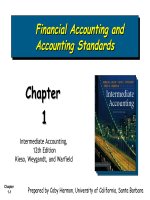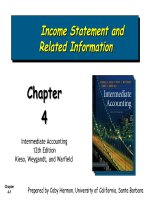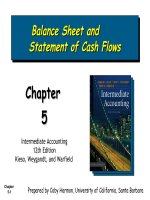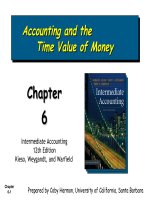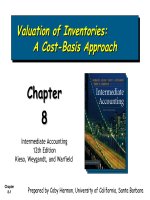Intermediate accounting 12th edition kieso warfield chapter 05
Bạn đang xem bản rút gọn của tài liệu. Xem và tải ngay bản đầy đủ của tài liệu tại đây (427.73 KB, 46 trang )
Balance
Balance Sheet
Sheet and
and
Statement
Statement of
of Cash
Cash Flows
Flows
Chapter
5
Intermediate Accounting
12th Edition
Kieso, Weygandt, and Warfield
Chapter
5-1
Prepared by Coby Harmon, University of California, Santa Barbara
Learning
Learning Objectives
Objectives
1.
Explain the uses and limitations of a balance sheet.
2.
Identify the major classifications of the balance sheet.
3.
Prepare a classified balance sheet using the report and
account formats.
4.
Determine which balance sheet information requires
supplemental disclosure.
5.
Describe the major disclosure techniques for the balance
sheet.
6.
Indicate the purpose of the statement of cash flows.
7.
Identify the content of the statement of cash flows.
8.
Prepare a statement of cash flows.
9.
Understand the usefulness of the statement of cash
flows.
Chapter
5-2
Balance
Balance Sheet
Sheet and
and Statement
Statement of
of Cash
Cash Flows
Flows
Balance
Sheet
Usefulness
Limitations
Classification
Additional
information
reported
Techniques of
disclosure
Chapter
5-3
Statement of
Cash Flows
Purpose
Content and
format
Preparation
Usefulness
Balance
Balance Sheet
Sheet
Usefulness of the Balance Sheet
Evaluating the capital structure.
Assess risk and future cash flows.
Analyze the company’s:
Chapter
5-4
Liquidity,
Solvency, and
Financial flexibility.
LO 1 Explain the uses and limitations of a balance sheet.
Balance
Balance Sheet
Sheet
Limitations of the Balance Sheet
Most assets and liabilities are reported at
historical cost.
Use of judgments and estimates.
Many items of financial value are omitted.
Chapter
5-5
LO 1 Understand the uses and limitations of an income statement.
Balance
Balance Sheet
Sheet
Classification in the Balance Sheet
Three General Classifications
Assets, Liabilities, and Stockholders’ Equity
Companies further divide these classifications:
Illustration 5-1
Balance Sheet
Classification
Chapter
5-6
LO 2 Identify the major classifications of the balance sheet.
Balance
Balance Sheet
Sheet
Current Assets
Cash and other assets a company expects to
convert into cash, sell, or consume either in one
year or in the operating cycle, whichever is longer.
Illustration 5-2
Accounts and
basis of valuation
Chapter
5-7
LO 2 Identify the major classifications of the balance sheet.
Balance
Balance Sheet
Sheet
Review
The correct order to present current assets is
a. Cash, accounts receivable, prepaid items,
inventories.
b. Cash, accounts receivable, inventories, prepaid
items.
c.
Cash, inventories, accounts receivable, prepaid
items.
d. Cash, inventories, prepaid items, accounts
receivable.
Chapter
5-8
LO 8 Explain how to report other comprehensive income.
Balance
Balance Sheet
Sheet –– “Current
“Current Assets”
Assets”
Cash
Generally any monies available “on demand.”
Cash equivalents are short-term highly liquid
investments that will mature within three
months or less.
Any restrictions or commitments must be
disclosed.
Chapter
5-9
Illustration 5-3
LO 2 Identify the major classifications of the balance sheet.
Balance
Balance Sheet
Sheet –– “Current
“Current Assets”
Assets”
Short-Term Investments
Portfolios
Type
Valuation
Classification
Held-toMaturity
Debt
Amortized
Cost
Current or
Noncurrent
Trading
Debt or Equity
Fair Value
Current
Availablefor-Sale
Debt or Equity
Fair Value
Current or
Noncurrent
Chapter
5-10
LO 2 Identify the major classifications of the balance sheet.
Balance
Balance Sheet
Sheet –– “Current
“Current Assets”
Assets”
Receivables
Claims held against customers and others for
money, goods, or services.
Accounts receivable – oral promises
Notes receivable – written promises
Major categories of receivables should be shown in
the balance sheet or the related notes.
Chapter
5-11
LO 2 Identify the major classifications of the balance sheet.
Balance
Balance Sheet
Sheet –– “Current
“Current Assets”
Assets”
Accounts Receivable – Presentation Options
11
22
Current Assets:
Cash
346
Accounts receivable
Less allowance for doubtful accounts
475
Inventory
812
Current Assets:
Total current assets
Cash
$ 346
Accounts
receivable, net of $25 allowance
475
$1,633
Inventory
Total current assets
Chapter
5-12
$
500
25
812
$1,633
LO 2 Identify the major classifications of the balance sheet.
Balance
Balance Sheet
Sheet –– “Current
“Current Assets”
Assets”
Inventories
Company discloses:
basis of valuation (e.g., lower-of-cost-ormarket) and
the method of pricing (e.g., FIFO or LIFO).
Chapter
5-13
LO 2 Identify the major classifications of the balance sheet.
Balance
Balance Sheet
Sheet –– “Current
“Current Assets”
Assets”
Prepaid Expenses
Payment of cash, that is recorded as an asset because
service or benefit will be received in the future.
Cash Payment
BEFORE
Expense Recorded
Prepayments often occur in regard to:
insurance
supplies
advertising
Chapter
5-14
rent
maintenance on equipment
LO 2 Identify the major classifications of the balance sheet.
Balance
Balance Sheet
Sheet –– “Noncurrent
“Noncurrent Assets”
Assets”
Long-Term Investments
Generally consists of four types:
Securities
Fixed assets
Special funds
Nonconsolidated subsidiaries or
affiliated companies.
Chapter
5-15
LO 2 Identify the major classifications of the balance sheet.
Balance
Balance Sheet
Sheet –– “Noncurrent
“Noncurrent Assets”
Assets”
Long-Term
Investments
Securities
Securities
bonds,
stock, and
long-term notes
For marketable securities,
management’s intent
determines current or
noncurrent classification.
Chapter
5-16
Balance Sheet (in thousands)
Current assets
Cash
$ 285,000
Investments:
Invesment in ABC bonds
Investment in UC Inc.
Notes receivable
Land held for speculation
Sinking fund
Pension fund
Cash surrender value
Investment in Uncon. Sub.
Total investments
Property, Plant, and Equip.
Building
Land
321,657
253,980
150,000
550,000
225,000
653,798
84,321
457,836
2,696,592
1,375,778
975,000
LO 2 Identify the major classifications of the balance sheet.
Balance
Balance Sheet
Sheet –– “Noncurrent
“Noncurrent Assets”
Assets”
Long-Term
Investments
Balance Sheet (in thousands)
Current assets
Cash
$ 285,000
Investments:
Fixed
Fixed Assets
Assets
Land held for
speculation
Invesment in ABC bonds
Investment in UC Inc.
Notes receivable
Land held for speculation
Sinking fund
Pension fund
Cash surrender value
Investment in Uncon. Sub.
Total investments
Property, Plant, and Equip.
Building
Land
Chapter
5-17
321,657
253,980
150,000
550,000
225,000
653,798
84,321
457,836
2,696,592
1,375,778
975,000
LO 2 Identify the major classifications of the balance sheet.
Balance
Balance Sheet
Sheet –– “Noncurrent
“Noncurrent Assets”
Assets”
Long-Term
Investments
Balance Sheet (in thousands)
Current assets
Cash
$ 285,000
Investments:
Special
Special Funds
Funds
Sinking fund
Pensions fund
Cash surrender
value of life
insurance
Chapter
5-18
Invesment in ABC bonds
Investment in UC Inc.
Notes receivable
Land held for speculation
Sinking fund
Pension fund
Cash surrender value
Investment in Uncon. Sub.
Total investments
Property, Plant, and Equip.
Building
Land
321,657
253,980
150,000
550,000
225,000
653,798
84,321
457,836
2,696,592
1,375,778
975,000
LO 2 Identify the major classifications of the balance sheet.
Balance
Balance Sheet
Sheet –– “Noncurrent
“Noncurrent Assets”
Assets”
Long-Term
Investments
Balance Sheet (in thousands)
Current assets
Cash
$ 285,000
Investments:
Nonconsolidated
Nonconsolidated
Subsidiaries
Subsidiaries or
or
Affiliated
Affiliated
Companies
Companies
Chapter
5-19
Invesment in ABC bonds
Investment in UC Inc.
Notes receivable
Land held for speculation
Sinking fund
Pension fund
Cash surrender value
Investment in Uncon. Sub.
Total investments
Property, Plant, and Equip.
Building
Land
321,657
253,980
150,000
550,000
225,000
653,798
84,321
457,836
2,696,592
1,375,778
975,000
LO 2 Identify the major classifications of the balance sheet.
Balance
Balance Sheet
Sheet –– “Noncurrent
“Noncurrent Assets”
Assets”
Property, Plant, and
Equipment
Assets of a durable
nature used in the
regular operations
of the business.
Balance Sheet (in thousands)
Current assets
Cash
Total investments
Property, Plant, and Equip.
2,696,592
Building
Land
Machinery and equipment
Capital leases
Leasehold improvements
Accumulated depreciation
Total PP&E
Intangibles
1,375,778
975,000
234,958
384,650
175,000
(975,000)
2,170,386
Goodwill
Patents
Trademarks
Chapter
5-20
$ 285,000
3,000,000
177,000
40,000
LO 2 Identify the major classifications of the balance sheet.
Balance
Balance Sheet
Sheet –– “Noncurrent
“Noncurrent Assets”
Assets”
Intangibles
Balance Sheet (in thousands)
Current assets
Lack physical
substance and are not
financial instruments.
Accumulated depreciation
Total PP&E
Intangibles
(975,000)
2,170,386
Goodwill
Patents
Trademark
Franchises
Copyright
Total intangibles
Other assets
2,000,000
177,000
40,000
125,000
55,000
2,397,000
Limited life
intangibles amortized.
Indefinite-life
intangibles tested for
impairment.
Chapter
5-21
Cash
Prepaid pension costs
Deferred income tax
Total other
$ 285,000
133,000
40,000
173,000
LO 2 Identify the major classifications of the balance sheet.
Balance
Balance Sheet
Sheet –– “Exercise”
“Exercise”
BE5-6 Mickey Snyder Corporation’s adjusted trial balance
contained the following asset accounts at December 31, 2007:
Prepaid Rent $12,000; Goodwill $40,000; Franchise Fees
Receivable $2,000; Franchises $47,000; Patents $33,000;
Trademarks $10,000. Prepare the intangible assets section of the
balance sheet.
Intangibles
Goodwill
$
40,000
Franchises
47,000
Patents
33,000
Trademarks
10,000
Total
$130,000
Chapter
5-22
LO 2 Identify the major classifications of the balance sheet.
Balance
Balance Sheet
Sheet –– “Noncurrent
“Noncurrent Assets”
Assets”
Other Assets
This section should
include only unusual
items sufficiently
different from assets
in the other
categories.
Chapter
5-23
Balance Sheet (in thousands)
Current assets
Cash
$ 285,000
Intangibles
Goodwill
Patents
Trademark
Franchises
Copyright
Total intangibles
Other assets
Prepaid pension costs
Deferred income tax
Total other
Total Assets
2,000,000
177,000
40,000
125,000
55,000
2,397,000
133,000
40,000
173,000
$ 9,210,978
LO 2 Identify the major classifications of the balance sheet.
Balance
Balance Sheet
Sheet
Current Liabilities
“Obligations that a
company reasonably
expects to liquidate
either through the use
of current assets or the
creation of other
current liabilities.”
Chapter
5-24
Balance Sheet (in thousands)
Current liabilities
Notes payable
$ 233,450
Accounts payable
131,800
Accrued compensation
43,000
Unearned revenue
17,000
Income tax payable
23,400
Current maturities LT debt
121,000
Total current liabilities
569,650
Long-term liabilities
Long-term debt
Obligations capital lease
Deferred income taxes
Total long-term liabilities
Stockholders' equity
979,500
345,800
77,909
2,093,859
LO 2 Identify the major classifications of the balance sheet.
Balance
Balance Sheet
Sheet
Long-Term Liabilities
Balance Sheet (in thousands)
Current liabilities
“Obligations that a
company does not
reasonably expect to
liquidate within the
normal operating cycle.”
Notes payable
$ 233,450
Accounts payable
131,800
Accrued compensation
43,000
Unearned revenue
17,000
Income tax payable
23,400
Current maturities LT debt
121,000
Total current liabilities
569,650
Long-term liabilities
All covenants and
restrictions must be
disclosed.
Chapter
5-25
Long-term debt
Obligations capital lease
Deferred income taxes
Total long-term liabilities
Stockholders' equity
979,500
345,800
77,909
2,093,859
LO 2 Identify the major classifications of the balance sheet.


